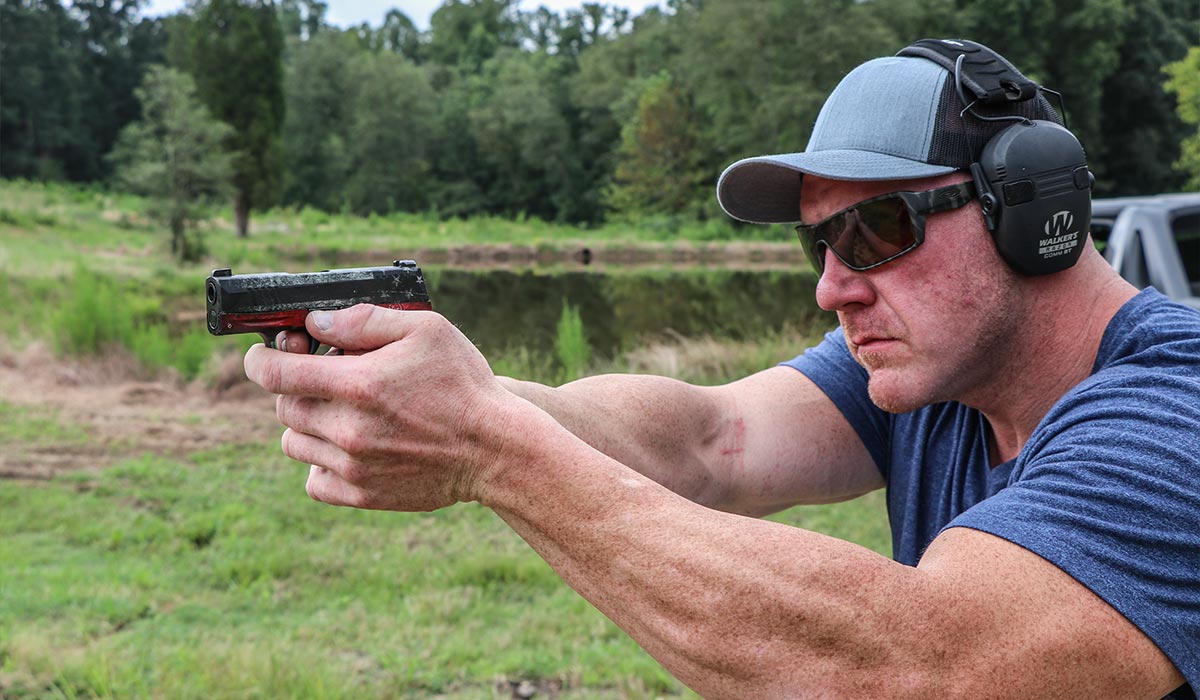8 Differences Between Combat Pistol Shooting and Competitive Pistol Shooting

Competitive and combat shooting are two scenarios gun owners might imagine themselves in. While they both obviously involve targets and your firearm, knowing the differences between them could be critical in a life or death situation.
Gun owners need to be trained and comfortable with their weapons in any situation. Competitive pistol shooting can be a great way to make an individual feel confident with their gun.
However, there’s a difference between training on a gun range with no immediate threat and being in a situation wherein you need to know what to do to take down danger.
Combat Shooting
Combat shooting is the action of using your handgun in a self-defense scenario. There are no metal targets, no bales to hide behind, and the stakes are more than likely higher than competitive shooting.
Gun owners certainly don’t want to be in a combat shooting situation, but the reason why 67% of gun owners originally armed themselves is so that they’ll be prepared if ever the circumstance comes up.
Competitive Shooting
Competitive pistol shooting is exactly that: Competition. Competitive shooting typically involves moving or still targets that can assess a shooter's accuracy and reaction times. This type of experience can be great for training gun owners to be prepared in the event of a combat situation, as there is no immediate danger, and the shooter can focus on their technique and handling.
Competitive shooting can be long-range or close distance, and some programs are even designed to replicate real-world situations.
How Are They Different?
While the circumstances of combat and competitive shooting are obvious, in one you’re in a firing range or field and the other you’re defending your own life, there are other key differences to keep in mind.
Especially if you’re a gun owner who uses competitive shooting to train for potential combat situations, knowing what you might be missing on the range will help prepare you for when you actively need to use your skills.
1. Targets Are Single Shot
In a competitive shooting environment, you usually train to hit the target once with as much accuracy as possible. However, this might be a detrimental practice in the real world.
The mentality of “one shot and move on'' won't do you much good in a dangerous environment; the threat might need multiple accurate shots to be taken down. Whether you’re handling a semi-automatic handgun or something larger, you’ll more than likely find that multiple rounds will be required.
Especially if the threat is unstable or in a type of rage, viewing them the same way you would a paper target won’t serve you well. If you do partake in competitive shooting or training environments, try to find a program that emphasizes multiple, accurate hits instead of just hitting the target once.
2. Which to Prioritize: Speed or Accuracy?
When you’re dealing with a self-defense scenario, and you’re protecting your life or the life of others, accuracy is the top priority. While speed is also important, it’s critical that you land hits on your target while you have the chance.
This isn’t quite the case in competitive shooting. While accuracy is obviously judged and grants points in a competition, there seems to be an emphasis on speed due to the timer. Because of this focus on speed, shooters have the possibility of developing a grip that lends itself more to moving quicker than it does accuracy.
For instance, the overhand grip that you might see shooters using is useful in a training situation where you’re just trying to hit as many targets as quickly as possible, but it doesn’t improve steadiness or accuracy the way a standard vertical grip can in the real-world.
Not to mention, you don’t have the pressure of your targets shooting back at you to deal with in a competition, while in a real-life defense moment, you’ll need to be able to hold on tight to your firearm.
3. No Urgent Need to Take Cover
As we mentioned, in a competitive or training environment where an individual is practicing their technique by shooting at targets, it’s safe to assume that they don’t also have to be concerned about returning fire. Unfortunately, this isn’t the case in a combat situation.
Combat is extremely dangerous, and you must take cover. If the threat has their own firearms or weapon, being open and exposed is a pretty fast way to end the situation, but not in your favor.
Your goal is to make yourself as small of a target as possible, whether you’re taking cover or peering out, waiting for the perfect moment to take a shot. While camouflage won’t do you much good outside of the woods, having a way for yourself and your gun to blend in with your surroundings isn't a bad idea, like the A-TACS Camo. They even have camo with urban and concrete colors.
If the situation is close range, you’ll need to find cover that you can easily maneuver behind so you don’t get trapped. Mobility and visibility are essential, and while it may be difficult to take the time to identify your best option, it’s extremely valuable to be able to locate and use optimal cover.
If you find yourself in long-distance combat, mobility becomes slightly less essential, but you still need something that you can safely use as cover while still being able to peek out and keep your eyes on the target.
4. Communication
In a combat situation, you’re probably not going to be alone. Communication skills are essential, whether you’re working with other gun owners to mobilize and develop a tactic or the unarmed that need to get out of harm's way.
Learning how to properly and calmly relay messages to others will make a huge difference in combat. You need to be able to quietly discuss a plan to simultaneously take down a threat and reduce the potential dangers for others around.
This skill isn’t really developed in a competitive environment. Shooters tend to find themselves alone, focusing on targets. As we’ve said before, these skills are also essential. Being confident enough in yourself and your firearm is critical.
However, if you don’t work on communicating with those around you, developing and following a plan, and taking note of your surroundings while in a stressful situation, you’re likely putting yourself and your “team” at a disadvantage.
5. Time
Maybe one of the biggest differences between the two is time and stamina. In a competition, a shooter might be required to quickly and accurately shoot multiple targets over the course of 10 seconds to a minute. Perhaps longer, depending on the competition.
Combat, on the other hand, has the potential to take much, much longer. You could find yourself facing an enemy for an hour, even longer, potentially depending on the circumstances. Work on your stamina, mentally and physically. Your body needs to be able to hold strong for as long as you can in a dangerous situation; your hands certainly can’t get tired when you need them.
Stress and adrenaline might boost your energy levels for a bit, but the crash is very real and can be particularly detrimental to your mental state. Practice breathing exercises and train under inconvenient circumstances so that if and when you need to hold steady, your body and mind are ready.
6. Perfect Circumstances Vs. The Real World
The day of a competitive shooter is going to be completely different than that of a combat shooter. The competition gun owner gets decent rest, knows what the day is going to look like, and prepares accordingly. There’s likely a roof to block out the sun, and you know what you’re showing up to the range to do.
Combat situations tend to be a bit more spur of the moment. Whether it’s military or self-defense, you could find yourself suddenly in combat at the drop of a hat. Without any preparation, mental or physical, you suddenly need to be ready to go.
Training yourself in perfect conditions is good for developing actual shooting skills, but being able to operate without proper rest, while out of breath, or just generally on an off day, will prepare you better for a combat situation. You never know when you’ll have to be ready, so introducing some practices that generally reduce your heart rate overall would be a good idea.
7. Unrealistic Configurations
In a competition setting or training environment, there is the possibility of limited target configurations. While this isn’t the case at all events, it’s something to keep an eye out for.
These standard configurations set up a gun owner to expect where their target is instead of using their reflexes. This can be pretty detrimental in a combat situation, as obviously, the threat you may face won’t be kind enough to place themselves where you’re used to targets being.
Be careful of developing too much muscle memory. Competition shooters have the potential to follow the patterns of where they’ve shot before and lock that into their technique instead of developing a sense of locating targets as they appear.
8. Unnecessary Gimmicks and Toys
Competition shooting tends to breed unnecessary toys that possibly enhance the competitive results but hinder a gun owner in a real-world situation. Laser sights and fancy holsters aren’t reliable in everyday use. Batteries can fail when you need them, and getting used to a speed holster might cause you to fumble when you deal with an everyday carry holster.
It isn’t that these gadgets are inherently bad. If you want to use them while training or to compete, then that’s absolutely fine. Certain upgrades can even benefit your situation, like tactical sights or high-quality grip friction liquid grip additive to increase grip.
But you should make sure to also train yourself with exactly what you would normally carry so that you aren’t unfamiliar with your setup when the time comes.
Wrapping Things Up
Competition shooting isn’t bad. In fact, many gun owners would more than likely benefit from the opportunity to learn their weapon and sharpen their skills as a shooter. Training in this environment can improve accuracy and speed, both of which will be essential when face to face with danger.
However, be aware of the difference between the training range you use and what a real-world situation would be like. You certainly don’t want to get comfortable with the wrong techniques or practices and suddenly find yourself fumbling in a combat situation.
Keep your weapon clean and prepared. Find cover, focus on accuracy, and don’t let gadgets and add-ons get in your way because, in a combat setting, you won't be judged on points, but you will be responsible for your own life and anyone else you may be protecting.
Sources:
Key takeaways on Americans’ views of guns and gun ownership | Pew Research Center
COMPETITIVE SHOOTING | NRA.org
6 Proven Ways to Lower Your Resting Heart Rate | HackenSackMeridianHealth.com



1 comment
Greetings. Thank you for pointing out the differences between real life encounters and USPSA type competitions. I keep hearing the words “shooting community”, and it seems that it is a community that cannot agree on many things. The guys that shoot 52 weekends a year, 3 times during the week, and in between sit at a reloading bench, have nothing but disdain for police officers and soldiers. As it happens, police officers and soldiers cannot be on a range 24/7. They have many other duties and responsibilities. Competition shooters can do that one thing better than most people because that is all they do. Soldiers do dozens and dozens of things that professional shooters cannot and will never do. There lies the problem. The division between factions/categories of gun owners. Just an opinion of a gun owner and soldier.